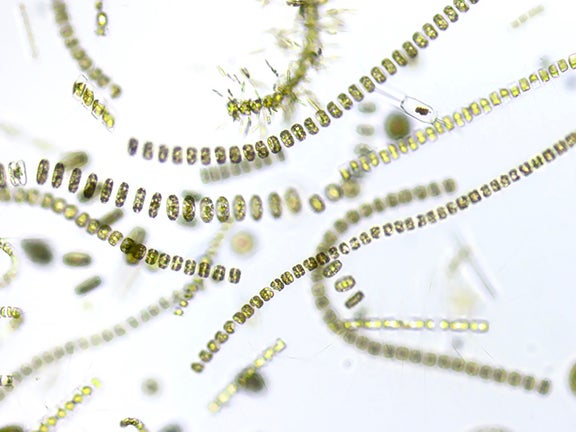November 17, 2021
Tiny marine plants called phytoplankton are the foundation of most food webs in the ocean, and their productivity drives commercial fisheries, carbon sequestration, and healthy marine ecosystems. But little is known about how they will respond to increasing ocean temperatures resulting from the changing climate. Most climate models assume they will all respond in a similar way.
But a team of researchers at the University of Rhode Island’s Graduate School of Oceanography, led by former doctoral student Stephanie Anderson, has concluded that different types of phytoplankton will react differently. An examination of how four key groups of phytoplankton will respond to ocean temperatures forecast to occur between 2080 and 2100 suggests that their growth rates and distribution patterns will likely be dissimilar, resulting in significant implications for the future composition of marine communities around the globe.
“Phytoplankton are some of the most diverse organisms on Earth, and they fix roughly as much carbon as all the land plants in the world combined,” said Anderson, now a postdoctoral researcher at the Massachusetts Institute of Technology. “Every other breath you take is generated by phytoplankton. And which ones are present affects which fish can be supported in a given region.”
Anderson, URI Oceanography Professor Tatiana Rynearson and colleagues from MIT, Scripps Institute of Oceanography and Old Dominion University published the results of their research in the Nov. 5 issue of the journal Nature Communications.
“This study represents a key contribution to the understanding of how phytoplankton respond to ocean warming,” said Rynearson. “All climate change forecasts of marine ecosystems include a term that reflects how we think phytoplankton growth responds to temperature. In this study we’ve generated new, more accurate values for the temperature-growth response that better reflect the diversity of phytoplankton in the ocean. These new values can be used in future climate change forecasts, helping them to become more accurate. “
The researchers compiled temperature-related growth measurements from more than 80 existing research studies on four types of phytoplankton – diatoms, which thrive in high-nutrient regions; cyanobacteria, which dominate in the open ocean where nutrients are low; coccolithophores, which are especially important in the uptake of carbon; and dinoflagellates, which migrate vertically in the water column. They also reviewed the heat tolerance for each group and conducted a simulation of projected temperatures to determine how phytoplankton distribution and growth rates would change in different parts of the world.
There’s a lot of capacity to handle warming towards the poles, but that capacity drops at the equator.Stephanie Anderson
They found that each group has a different tolerance for warming.
“The coccolithophores will probably face the greatest proportional growth decreases near the equator, which could potentially alter community composition there,” Anderson said. “The cyanobacteria, on the other hand, are expected to face the greatest proportional growth increases at mid-latitudes, and they might expand their range poleward.”
“We were surprised that our simulations predicted the greatest range shift for the cyanobacteria in the Gulf of Alaska and northeast Pacific Ocean, regions that support rich and abundant fisheries,” Rynearson added. “Importantly, cyanobacteria are not known to be very good fish food.”
The researchers said that all four phytoplankton groups are expected to increase their growth rates in cooler regions, but the degree of increase varies by group.
“With all the groups, we expect their growth rates to decrease closer to the equator,” Anderson said. “The equator is already the warmest region, so increasing temperatures there might push them to their limits. The temperatures there will exceed the levels they’re comfortable at, which will hinder their growth.”
Most species can tolerate temperatures greater than those they typically face, the researchers said, but the margin between what they typically face and the level at which they cannot survive decreases the closer they get to the equator.
“There’s a lot of capacity to handle warming towards the poles, but that capacity drops at the equator,” Anderson said.
The research team also found that the dinoflagellates had the smallest change in growth rate in response to increasing temperature of all of the groups examined, and they tolerated the widest range of temperatures.
“Their metabolic rates are not as likely to be affected by temperature changes as the other groups,” said Anderson. “We hypothesize that it could be due to the fact that they are vertical migrants. Their ability to swim up and down exposes them to more temperatures, potentially enabling them to handle more temperature change.”
The implications of these results are significant. At the equator, where phytoplankton growth rates are projected to decrease as temperatures increase, the reduced biomass of phytoplankton may support fewer fish and other marine organisms.
“If you’re a fish and you’re dependent on one type of food and that’s no longer present, you might have to move with your prey to survive,” Anderson said. “This could lead to shifts in food webs regionally.”
At higher latitudes where growth rates are predicted to increase, the higher biomass of phytoplankton may be able to support a greater number of fish, providing a boost to commercial fisheries.
The study did not consider other factors that might affect phytoplankton growth rates, like nutrient or light availability, so Anderson said the implications of the study are somewhat speculative. She is now incorporating those additional factors into a new model to see how the results may change.

